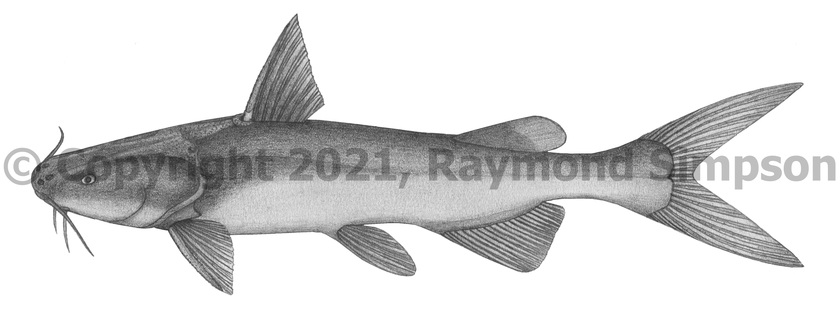
Common Name
Cazon Sea Catfish
Year Described
Miles, 1945
Identification
Dorsal Fin: I, 7
Anal Fin: 19-21
Pectoral Fin: 10-13 rays
Pelvic Fin: 6
Caudal Fin: 13 branched (6 upper, 7 lower)
Gill Rakers: 13-15 on first arch, 15-17 on second arch
Notarius is defined by the combination of the following characters described in Marceniuk & van der Steen (2017): medial fleshy groove absent, fenestra moderately well developed between frontal and lateral ethmoid, posterior cranial fontanel moderately developed, epiooccipital not projecting into dorsal shield, posterior occipital process rectangular or slightly constricted, nuchal shield crescent shaped, accessory tooth plates round when present, and adipose fin as long as anal fin.
Body elongate and robust with a strongly arched back. Greatest body depth at dorsal fin. Snout broadly rounded. Nostrils not connected by a furrow. Anterior nostril fleshy and posterior covered by a flap. Cephalic shield does not extend forward to between eyes. No fleshy furrow in the middle of head shield. Medial depression present as a notch on the anterior margin of the head shield. Shield covered in skin but textured to the touch. Supraoccipital longer than wide and narrowing posteriorly. Lateral projections of head shield triangular and projecting above opercle. Nuchal plate narrow and crescent shaped with obvious bumpy texture. Eye small. Mouth subterminal and wide with fleshy lips. There are three pairs of barbels (one maxillary and 2 mental) with the maxillary barbel not reaching the pectoral fin. A single arched patch of villiform teeth cross maxillary. Palatine teeth in four patches paired on roof of mouth. Teeth conical. Gill rakers present on all arches. Dorsal fin high with a strong serrated spine. Pectoral fins about the same size as dorsal fin with strong, weakly serrated spines. Pelvic and anal fins located far back on body. Adipose fin present over anal fin base. Caudal fin strongly forked. Body naked.
Color
Head and dorsum blackish to blue-black, becoming abruptly whitish on flanks and belly. Fins unformly grayish.
Size
Maximum size to 84.5cm TL but mostly under 60cm TL. This is the second largest Atlantic ariid catfish.
Habitat
Known from mostly freshwater but likely tolerates low salinities near the river mouths. This species is never found in full seawater.
Range
Found only in Atlantic slope Colombia (Rio Atrato and Magdalena), from higher elevation to the mouths of each river.
References
Arturo, A.P., & Ricardo, B.R. 2006. Real identity of the northern Colombian endemic sea catfish Galeichthys bonillai Miles, 1945 (Siluriformes: Ariidae). Cybium (Paris), 30(3), 215-219.
Betancur-R, R., & Acero, A. 2004. Description of Notarius biffi n.sp. and redescription of N. insculptus (Jordan and Gilbert) (Siluriformes: Ariidae) from the Eastern Pacific, with evidence of monophyly and limits of Notarius.
Marceniuk, A.P. & van der Steen, P. 2017. Family Ariidae. In: van der Sleen, P., & Albert, J.S. (Eds.). 2017. Field guide to the fishes of the Amazon, Orinoco, and Guianas (Vol. 115). Princeton University Press.
Other Notes
This species has been frequently misidentified as the New Grenada Sea Catfish (Ariopsis canteri) which is common in more marine habitats in coastal Colombia. The redescription of Notarius bonillai by Arturo & Ricardo (2006) limits this species to mostly freshwaters of Colombia, and it is likely a sister species of the Pacific N. cookei that was captured in the Atlantic slope rivers by geologic upheavels associated with the Panama uplift.